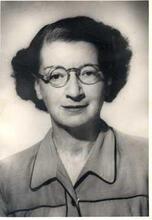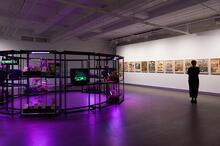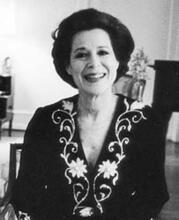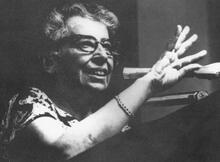Gerty Theresa Cori
Biochemist Gerty Theresa Radnitz Cori (1896-1957) and her husband Carl Ferdinand Cori (1896-1984) were jointly awarded the Nobel Prize in medicine in 1947 for their work on how the human body metabolizes sugar.
Image courtesy of the Smithsonian Institution.
Gerty Cori’s work on carbohydrate metabolism, which changed our understanding of diabetes, earned her the Nobel Prize for Medicine, making her the first American woman given the honor. The daughter of a chemist, Cori met her husband and collaborator Carl Cori in medical school, where they published their first joint paper together. After immigrating to America from Prague, they both worked at Buffalo’s State Institute for the Study of Malignant Disease. The Coris collaborated heavily on their work, and while Gerty Cori’s position at various institutions was often for a nominal salary, Carl refused to take any position that excluded her. They mapped the process by which glucose and glycogen transform in the liver and bloodstream, discovering a new step that won them the Nobel prize.
In the radio series This I Believe, Gerty Cori, the first American woman to be awarded the Nobel prize, which she shared with her husband and lifelong collaborator, Carl Cori (1896–1984) in 1947, stated, “Honesty, which stands mostly for intellectual integrity, courage and kindness are still the virtues I admire, though with advancing years the emphasis has been slightly shifted and kindness seem more important to me than in my youth. The love for and dedication to one’s work seem to me to be the basis for happiness.”
Early Life and Education
Gerty’s interest in studying medicine was sparked by her maternal uncle, a professor of pediatrics. Born on August 15, 1896, in Prague (then part of the Austro-Hungarian Empire) to an upper-middle-class Jewish family, Gerty was the oldest of three daughters of Otto Radnitz, a chemist who was a manager of sugar refineries, and Martha Neustadt. Initially tutored at home and then graduating from a girls’ finishing school, Gerty was ill-prepared to study medicine. At the age of eighteen, after making up her academic deficiencies in two years of concentrated study at a gymnasium, she successfully matriculated at the medical school of the German University in Prague. In her first year at medical school she became a constant companion of fellow student Carl Cori, with whom she shared many interests, love of the outdoors and fascination with basic scientific research. While students, Gerty and Carl published their first joint research paper on immune bodies in disease and thus began a most productive collaboration. World War I interrupted their medical education; Carl was drafted into the Austrian army in 1916, while Gerty spent the next two years as an assistant at the medical school, doing routine work.
Resuming their medical studies after the war, they received their medical degrees in 1920 and married, in spite of the opposition of his family, who were convinced that her Jewish background would hamper Carl’s career. Though Gerty converted to Catholicism, she was unsuccessful in assuaging their fears.
Immigration
Turning to research careers, they found positions in Vienna, Gerty at the Karolinen Children’s Hospital and Carl at the University of Vienna. Both managed to do research with minimal facilities. Carl moved on to the University of Graz, but Gerty, unable to obtain a position there, remained in Vienna. Their decision to leave Europe was fueled primarily by rampant antisemitism. Fortunately Carl was offered a position as a biochemist at the State Institute for the Study of Malignant Disease in Buffalo, New York, which he accepted with alacrity. Gerty followed six months later when an assistant pathologist position became available there. They never regretted their decision to emigrate. Enthusiastically embracing American culture, they became United States citizens in 1928.
Research
Their research focused on carbohydrate metabolism and the bulk of their eighty publications between 1922 and 1931 were joint. With a couple interacting so intimately, it is difficult to divide credit between them and no attempt will be made to do so. The question they addressed was what regulates blood sugar levels. Balance experiments on glucose metabolism in rats demonstrated that the breakdown of muscle glycogen as modulated by insulin and epinephrine, led to formation of blood lactic acid which then forms glycogen in the liver. The liver in turn releases glucose to the blood, which transports it to the muscle where glycogen is reformed. Their formulation of the Cori cycle of glycogen metabolism answered the question they had posed. Their success resulted from their development of precise analytical methods for the determination of glucose, glycogen, lactic acid, inorganic and organic phosphates—a strength and hallmark of all their future work.
In 1931, after refusing a position at a university that would prohibit Gerty from working with him, Carl accepted the chairmanship of the Pharmacology Department at Washington University in St. Louis, where Gerty was given a research assistantship at a nominal salary. Their research on glycogenolysis flourished. In 1936, extending their quantitative analytical methods to hexose monophosphates in glycogenolysis, they discovered a new intermediate, glucose-1-phosphate, the Cori ester. That same year Gerty gave birth to their only child, Thomas Carl, an event that did not change her dedication to her work.
The Coris launched a full-fledged effort in enzymology, concentrating on phosphorylase, the enzyme which converts glycogen to glucose-1-phosphate. The formation of glycogen in the reverse reaction was the first demonstration of synthesis of a macromolecule in a test tube, contradicting concepts then current. Reporting two forms of phosphorylase and their interrelationships, the Coris foreshadowed regulation by protein phosphorylation, now known to be a major regulatory mechanism of numerous cellular processes. Recognition by the Nobel committee in Physiology or Medicine followed, citing “their discovery of the course of the catalytic conversion of glycogen.” The award was shared with Bernardo Houssay. Unfortunately 1947 was also the year when Gerty was diagnosed with myelosclerosis, a debilitating bone marrow disease. Nevertheless, her dedication to science continued unabated.
In 1946 Carl was appointed chairman of Biochemistry at Washington University and Gerty was promoted to associate professor. Shortly before receiving the Nobel Prize, she reached the top of the academic ladder, full professorship. Scientists from all over the world flocked to this Mecca of enzymology to work with the Coris. Among those mentored by them, six subsequently received the Nobel prize.
In the last decade of her life Gerty continued to do groundbreaking research. She discovered the branching and debranching enzymes which catalyze the formation and breakdown, respectively, of branch points in glycogen. In her last research project, Gerty identified the individual enzyme defect in various forms of inherited glycogen-storage diseases in children, establishing for the first time that the lack or impairment of a single enzyme activity could cause a disease.
Legacy
Among the many honors Gerty Cori received were: American Chemical Society: Midwest Award and Garvan Medal; National Academy of Sciences: Sugar Research Prize; Borden Award: Association of Medical Colleges; Nobel Prize in Physiology or Medicine. She was also elected to the National Academy of Sciences, the American Academy of Arts and Sciences and the American Philosophical Society.
On October 26,1957, at age sixty-one, Gerty Cori succumbed to her illness. It was difficult to accept that this vivacious, outgoing person with her quick, sharp mind and her passionate love of science—an inspiration to all who spent time in the Cori lab—was gone.
Cohn, Mildred. “Carl and Gerty Cori.” In Creative Couples in Science (Lives of Women in Science), edited by Helena M. Pycior, Nancy G. Slack, Pnina G. Abir-Am.
Piscataway, New Jersey: Rutgers University Press, 1995.
Cori, Carl F. and Cori, Gerty T. “Polysaccharide Phosphorylase.” In Nobel Lectures in Physiology or Medicine 1942–1962. Amsterdam: Elsevier Publishing Company, 1964.
Larner, Joseph. “Gerty Theresa Cori.” In Biographical Memoirs, National Academy of Sciences 61 (1992): 111–135.
McGrayne, Sharon Bertsch. Nobel Prize Women in Science: Their Lives, Struggles and Momentous Discoveries. Malden, MA: Joseph Henry Press, 1998.













